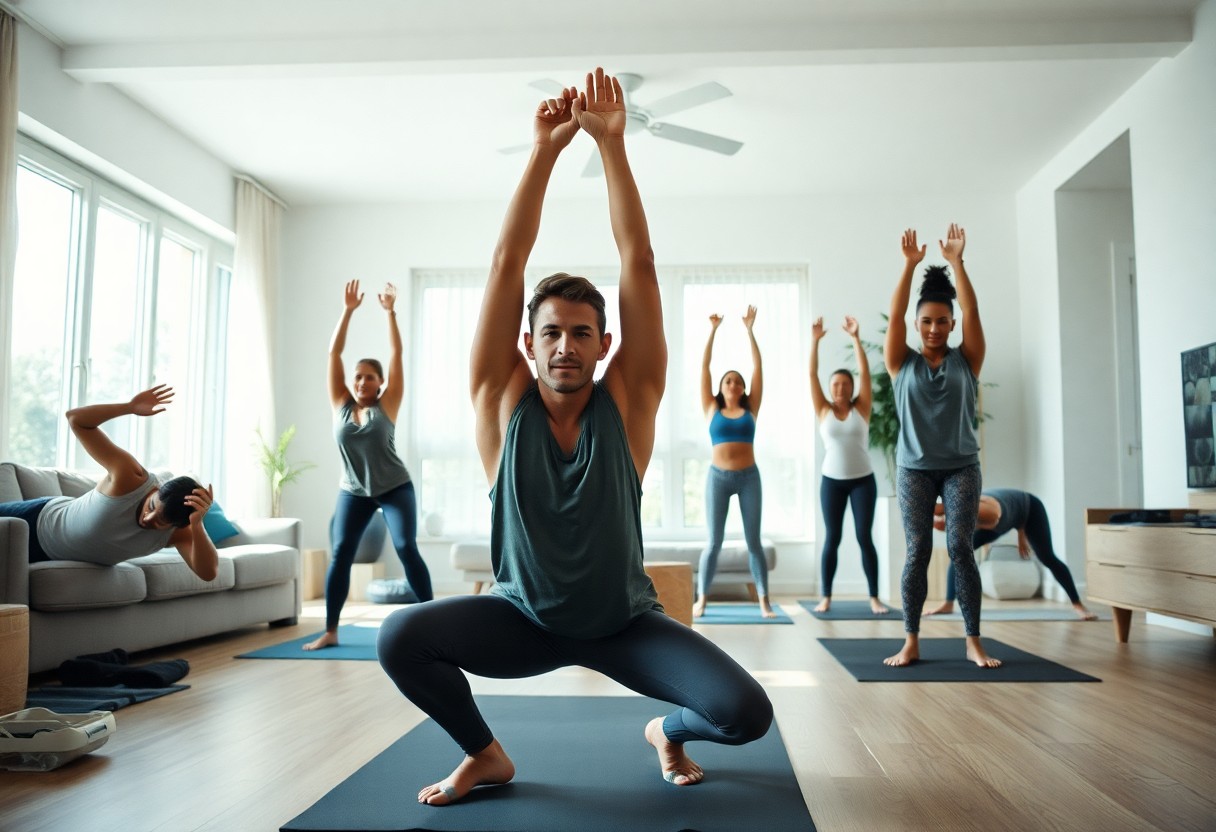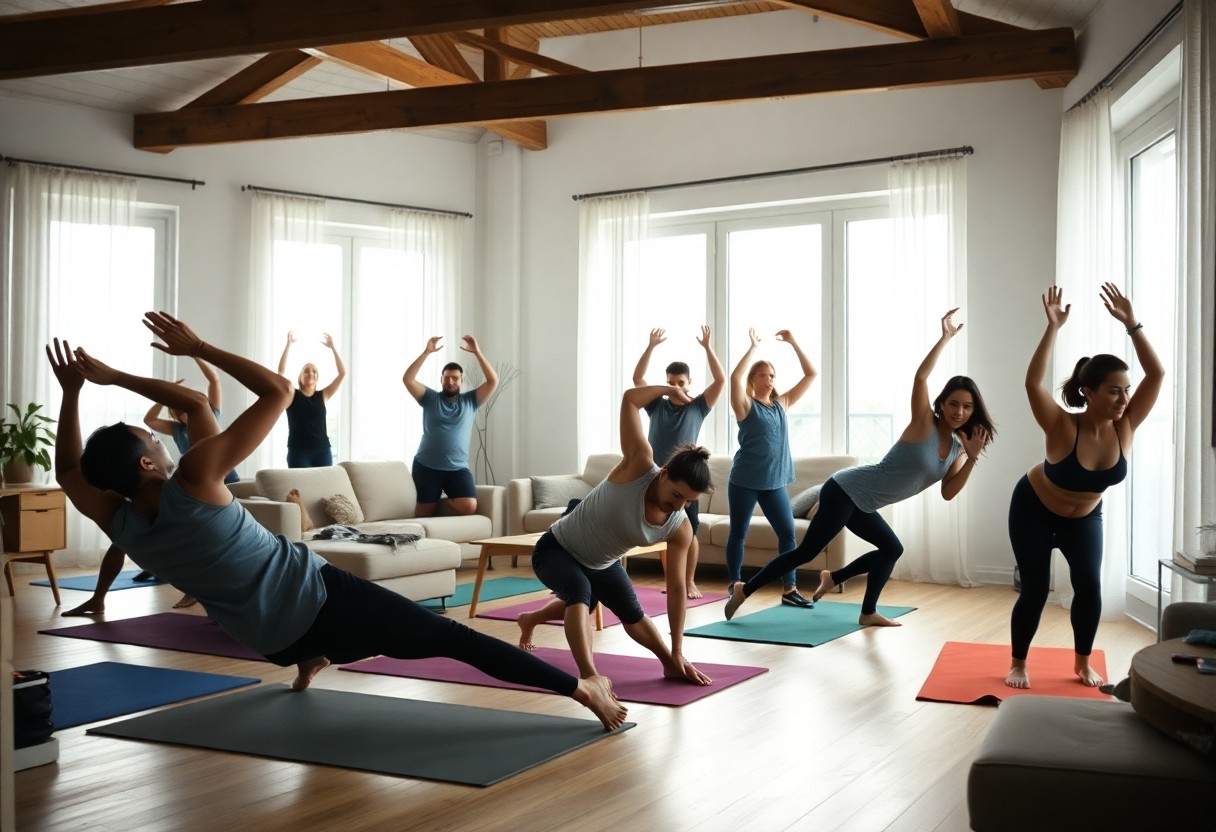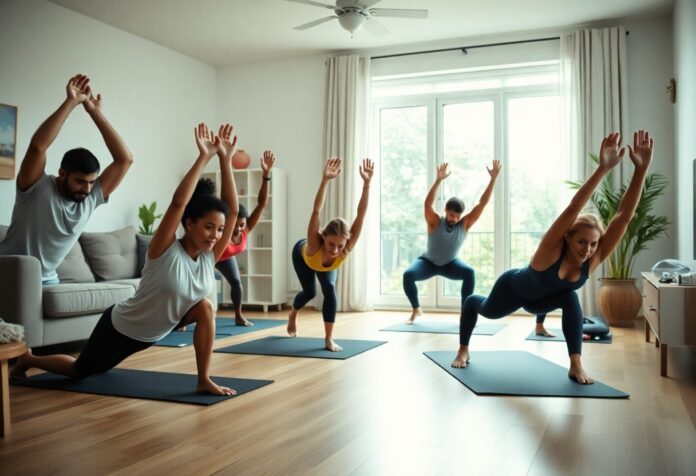This guide is designed to help you maximize your fitness journey by providing a variety of effective workouts that require no equipment. By focusing on bodyweight exercises, you can enhance your strength, flexibility, and endurance from the comfort of your home. You’ll discover how to create personalized routines that fit your schedule and lifestyle while keeping safety in mind. With the right mindset and motivation, you can achieve amazing results without the need for a gym or elaborate equipment. Let’s get started on transforming your living space into a personal fitness sanctuary!

Types of Home Workouts
While there are many different types of home workouts to choose from, it is necessary to find what resonates with you. Engage in a variety of routines to keep your exercises fresh and exciting. Here’s a quick overview:
| Type | Description |
|---|---|
| Bodyweight Exercises | Utilize your body weight for resistance, requiring no special equipment. |
| Cardio Workouts | Activities that elevate your heart rate, improving endurance and cardiovascular fitness. |
| Yoga | Focus on flexibility, strength, and mental well-being through various poses and stretches. |
| Pilates | Emphasizes core strength and stability, aligning your body through controlled movements. |
| HIIT | Short bursts of intense activity followed by brief rest periods for maximum efficiency. |
The balance of these workout types allows you to create a well-rounded fitness plan that targets different areas of your body, keeping your sessions both effective and enjoyable.
Bodyweight Exercises
Clearly, bodyweight exercises are one of the most accessible ways to work out at home, as they require no equipment while still providing a challenging workout. Exercises like push-ups, squats, and lunges can enhance your strength and flexibility, utilizing your body as the primary form of resistance. You can easily modify these exercises to suit your fitness level, from beginner to advanced. This adaptability enables you to build upon your progress without the need for gym equipment.
Incorporating various bodyweight movements into your routine can also boost your overall fitness. Pair exercises in a circuit or perform them consecutively to build endurance. As your comfort level increases, you can explore more advanced variations to continue challenging your muscles in innovative ways.
Cardio Workouts
Workouts that focus on cardiovascular fitness are necessary to any exercise regime. These cardio workouts elevate your heart rate and enhance lung capacity, contributing to improved overall health. Whether you prefer jumping jacks, high knees, or running in place, incorporating these activities into your daily routine can yield significant benefits. You might find that just 20-30 minutes of consistent cardiovascular exercise can lead to improved stamina and weight management.
Cardio workouts can be tailored to fit your personal preferences and available space. You can experiment with different activities, such as dancing, skipping rope, or even shadowboxing. The goal is to keep your heart rate up and maintain a fun atmosphere during the workout, ensuring you stay motivated and committed to your fitness journey.
Tips for Effective Home Workouts
One way to ensure you get the most out of your home workouts without equipment is to incorporate some important tips into your routine. These strategies can help maximize your efficiency and keep you on track to achieve your fitness goals. Here are a few pointers to consider:
- Focus on your form to prevent injury and enhance muscle activation.
- Set specific and achievable goals to maintain a clear direction.
- Create a dedicated workout space to minimize distractions.
- Vary your workouts to keep things interesting and prevent plateaus.
- Include warm-ups and cool-downs to support recovery and flexibility.
The key to effective home workouts is understanding how to create and stick to a routine that fits into your lifestyle.
Creating a Routine
With a proper routine in place, you can elevate your home workouts from haphazard to highly effective. Start by setting specific days and times for your workouts, treating them as appointments that you cannot miss. You can mix different types of exercises, such as bodyweight strength training, cardio, and flexibility work to build a well-rounded program that challenges your body in different ways. Tracking your progress can help you stay accountable and encourage you to push further as you notice your improvements.
Additionally, consider your energy levels throughout the week. If you know you feel more energized in the morning, schedule your workouts during that time. Flexibility is key; if life gets in the way, don’t hesitate to adjust your routine. The more you adapt your schedule to your lifestyle, the more likely you are to stick with it.
Staying Motivated
Some days, you may find it challenging to stay motivated for your home workouts. It’s perfectly normal to experience highs and lows in your exercise enthusiasm. To boost your motivation, try to set up a fun and engaging environment. Create a playlist of high-energy music that gets you pumped and ready to work out. Sharing your fitness journey with friends or family can also provide an added layer of support and encouragement. Additionally, consider setting small, incremental goals that can be achieved in a short period, making your progress feel more tangible and rewarding.
The key to staying invested in your home workout routine is finding what genuinely inspires you. Consider incorporating challenges, such as a new exercise each week or joining an online fitness community to connect with others. Celebrating your successes, no matter how small, can significantly contribute to a positive mindset. By focusing on the benefits you gain from working out—like increased energy, improved mood, and enhanced strength—you can create a sustainable workout habit that lasts. Your fitness journey is uniquely yours, so embrace it and enjoy the ride!
Step-by-Step Guide to Common Exercises
Even if you are new to working out at home, mastering a few basic exercises can lead to significant gains in strength and fitness. This guide breaks down some common exercises into simple steps, making it easy for you to follow along and find success without any equipment. Each exercise can be performed in the comfort of your own home and is perfect for all fitness levels.
| Exercise | Steps |
| Push-Ups | 1. Start in a plank position with your hands slightly wider than shoulder-width apart. 2. Lower your body until your chest nearly touches the floor. 3. Push your body back up to the starting position. |
| Squats | 1. Stand with your feet shoulder-width apart. 2. Lower your hips back and down as if sitting in a chair. 3. Keep your chest up and knees behind your toes. 4. Return to standing. |
Push-Ups
Clearly, push-ups are a fantastic exercise that targets multiple muscle groups, including your chest, shoulders, and triceps. To perform a push-up correctly, ensure your body stays in a straight line from head to heels throughout the movement. Avoid letting your hips sag or sticking your butt up in the air; both can lead to improper form and reduce the effectiveness of the exercise.
Furthermore, if you find standard push-ups challenging, you can modify the exercise by performing them on your knees or against a wall to suit your current fitness level. As you gain strength, aim to progress to full push-ups and challenge yourself with varied styles, such as incline or decline push-ups.
Squats
On the other hand, squats are a fundamental movement that engages your lower body muscles, including the quadriceps, hamstrings, and glutes. To execute a proper squat, you must focus on maintaining an upright posture while pushing your hips back as you lower your body. This will help ensure your knees align over your ankles, minimizing strain and maximizing efficiency.
Step by step, as you become more comfortable with squats, you can integrate variations such as jump squats or sumo squats to further challenge yourself and diversify your workout routine. Squats are not only beneficial for building lower body strength but also improve your overall balance and stability.
Factors to Consider for Home Workouts
Despite the accessibility and convenience of home workouts, there are several factors to consider to ensure you achieve your fitness goals effectively. First, assess your personal circumstances and environment to create a workout plan that suits your needs. Consider the following points:
- space availability
- noise levels
- time management
- motivation levels
Assume that addressing these factors will help you stay consistent and make your workout sessions more productive.
Space and Environment
Little thought is often given to the space you have available when conducting home workouts. It’s imperative to create a designated area that allows you to move freely and comfortably while exercising. Make sure this space is well-lit and ventilated, as a pleasant environment can greatly enhance your workout experience.
Moreover, consider the potential distractions that may arise in your home environment. Eliminating unwanted noise or interruptions can help maintain your focus and allow for a more fulfilling workout session. Be mindful of items that may obstruct your movements, and clear the area of clutter to optimize your workout routine.
Personal Goals
Any successful workout regime starts with a clear understanding of your personal goals. Knowing what you want to achieve through your home workouts—be it weight loss, muscle gain, or improved endurance—will directly influence your workout strategy. Establishing tangible, realistic goals will help you measure your progress and maintain motivation.
Goals like committing to a regular workout schedule, accomplishing a specific number of repetitions, or even mastering particular exercises can instill a sense of achievement. You might find this journey enables you to embrace a healthier lifestyle while realizing your own potential. Stay mindful of your strengths and areas for improvement, ensuring that your personal goals remain relevant and inspiring throughout your fitness journey.

Pros and Cons of Home Workouts
To make informed decisions about your fitness journey, it’s crucial to weigh the pros and cons of home workouts. While exercising at home offers flexibility and convenience, it also comes with its own set of challenges. Below is a breakdown of key advantages and disadvantages to consider.
| Pros | Cons |
|---|---|
| Flexibility in scheduling workouts | Potential for distractions at home |
| No requirement for expensive gym memberships | Limited space or equipment can hinder progress |
| Comfort of being in your own space | Lack of social interaction may affect motivation |
| Ability to customize workouts based on preferences | Possible difficulties in maintaining proper form without guidance |
| Convenience of not traveling to a gym | Finding accountability can be challenging |
| Workouts can be done at any time | Noise level or lack of privacy may be an issue |
Advantages
One of the standout benefits of home workouts is the flexibility they offer. You have the freedom to schedule your sessions at times that suit you best, allowing you to fit fitness into a busy lifestyle with ease. This adaptability means you can prioritize your workout around work, family commitments, or other responsibilities, significantly improving your chances of sticking with your routine. Additionally, there’s no need for gym memberships, which can save you a significant amount of money over time.
Another advantage is the comfort and privacy of your own environment. Being at home means you can wear whatever you like, set the room temperature to your liking, and play your choice of music without worrying about gym etiquette. This atmosphere can help to create a more relaxed feeling, leading to a more enjoyable workout experience. Plus, customizing your workouts based on your interests and available space helps you stay engaged and motivated.
Disadvantages
There’s no denying that home workouts come with some challenges. One of the most significant issues is the potential for distractions while trying to exercise at home. Whether it’s other household members, pets, or the allure of your comfy couch, maintaining focus can become a hurdle. Additionally, the lack of access to various equipment found in a gym might limit the types of workouts you can perform, ultimately affecting your progress.
For instance, without a personal trainer or workout partner, it can be difficult to ensure you are maintaining proper form during exercises, which may increase your risk of injury. Furthermore, the temptations of relaxing in your home may cause you to skip workouts or cut them short. Establishing a routine that minimizes distractions and creates a motivating environment is crucial for overcoming these obstacles and achieving your fitness goals.
Additional Resources for Home Workouts
All of these home workout techniques can be enhanced with the right resources. Online videos and workout programs are some of the most accessible options available, allowing you to choose exercises that fit your skill level and preferences. Platforms like YouTube, fitness apps, and streaming services offer thousands of workout tutorials that range from high-intensity interval training (HIIT) to yoga. Taking advantage of these resources means you can customize your workout regime while receiving expert guidance on form and technique. Most importantly, many of these videos are free, making it easy for you to stay motivated and engaged without spending a dime.
Online Videos and Programs
Resources for online workout videos can be overwhelming due to the sheer volume of options at your disposal. To streamline your efforts, find channels or programs that have a loyal following and positive reviews, as these often yield the most beneficial results. Follow along with a reputable instructor to ensure you’re performing each move correctly and safely. You can also explore structured programs that take you step-by-step through various workouts, which can provide the much-needed guidance to keep you consistent and on track.
Community and Support Groups
If you’re looking for additional encouragement and accountability, consider joining community and support groups that focus on home workouts. These groups can be found on social media platforms, online forums, or even local meetups, and they create spaces where you can share progress, exchange tips, and motivate each other. Being part of a community can significantly enhance your commitment, as you’re not only accountable to yourself but to others striving for similar fitness goals.
Home workout communities often foster a supportive environment, which can keep your spirits high even when you face challenges. Many groups organize challenges, provide workout schedules, and even share meal plans, which can help enhance your overall fitness journey. Participating in discussions about workouts you enjoy or struggle with allows you to benefit from the experiences of others, while also sharing your insights. This social aspect makes the workout experience far more enjoyable and ensures you stay focused on your goals.
Summing up
Conclusively, committing to home workouts without equipment offers you the flexibility to achieve your fitness goals effectively, regardless of your circumstances or location. You can utilize your body weight to perform a variety of exercises that enhance strength, flexibility, and cardiovascular health. Moreover, creating a consistent routine at home can contribute to your overall well-being, providing both physical and mental benefits as you stay active without the need for a gym membership or extensive equipment.
As you commence on your fitness journey, make use of the tips and strategies outlined in this guide to craft personalized workout sessions that cater to your preferences and needs. Explore different exercises, find out what works best for your body, and adjust your routine as you progress. By integrating these home workouts into your daily life, you’ll develop a sustainable fitness habit that promotes a healthier, stronger, and happier you.


